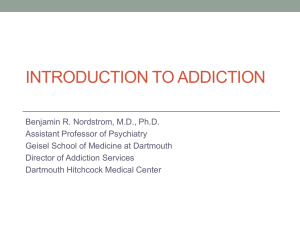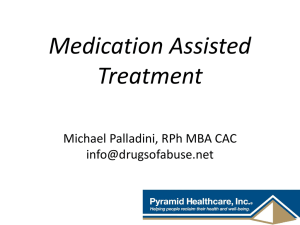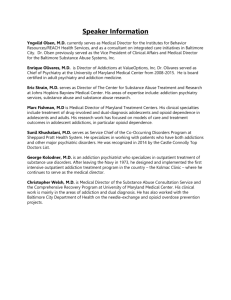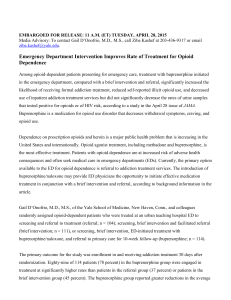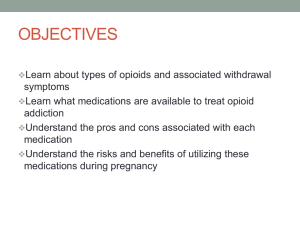Research Proposal
advertisement
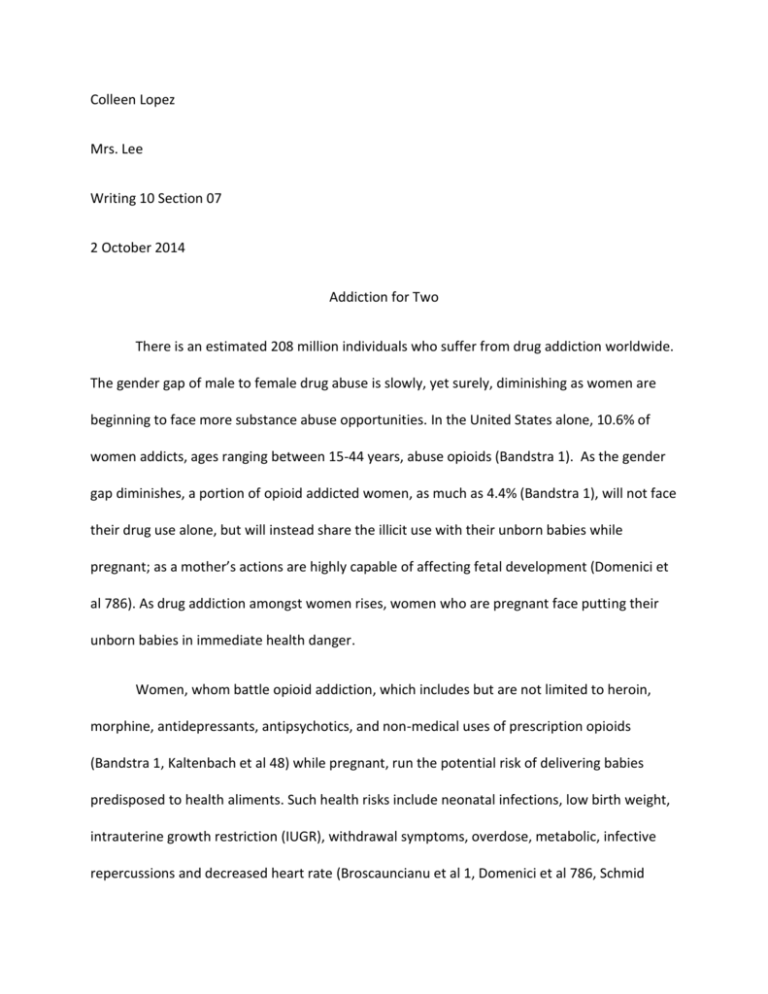
Colleen Lopez Mrs. Lee Writing 10 Section 07 2 October 2014 Addiction for Two There is an estimated 208 million individuals who suffer from drug addiction worldwide. The gender gap of male to female drug abuse is slowly, yet surely, diminishing as women are beginning to face more substance abuse opportunities. In the United States alone, 10.6% of women addicts, ages ranging between 15-44 years, abuse opioids (Bandstra 1). As the gender gap diminishes, a portion of opioid addicted women, as much as 4.4% (Bandstra 1), will not face their drug use alone, but will instead share the illicit use with their unborn babies while pregnant; as a mother’s actions are highly capable of affecting fetal development (Domenici et al 786). As drug addiction amongst women rises, women who are pregnant face putting their unborn babies in immediate health danger. Women, whom battle opioid addiction, which includes but are not limited to heroin, morphine, antidepressants, antipsychotics, and non-medical uses of prescription opioids (Bandstra 1, Kaltenbach et al 48) while pregnant, run the potential risk of delivering babies predisposed to health aliments. Such health risks include neonatal infections, low birth weight, intrauterine growth restriction (IUGR), withdrawal symptoms, overdose, metabolic, infective repercussions and decreased heart rate (Broscauncianu et al 1, Domenici et al 786, Schmid Lopez 2 1267). Drug withdrawal symptoms, otherwise known as Neonatal Abstinence Syndrome (NAS), range anywhere from tremors, irritability, hyperactivity, hypertonia, convulsions, fits of crying, excessive sweating and salivation, high temperature, sneezes, yawns, nasal stuffiness, vomiting, diarrhea, and eating to suction disorders (Domenici et al 786). Infections amongst newborns with drug addicted mothers can also lead to serious illness and or death (Broscauncianu et al 139). Neonates in this particular scenario are substantially exposed to the micro-organisms within the vagina during birth and or throughout the gestation period. Such micro-organisms include rubella, herpes, syphilis, and other potentially life-threatening contagions (Broscauncianu et al 140). As many as 88% of the 25 babies with drug addicted mothers examined faced some type of neonatal sickness (142). A plausible explanation as to why an opioid addicted mother contracts an infection and passes aliment to offspring could in fact be stimulated by the possibility that the woman has had little to no health screening while pregnant. Maternal check-ups during pregnancy could be affective in detecting possible sexual and blood transmitted diseases. Doctors would also have the ability of keeping tabs on an expectant mother’s nutrition; all of which are factors that could potentially harm a fetus and ultimately led to passage of infections between mother and child. A mother’s lifestyle might also increase her risk of catching aliments which then appear in her baby (babies) as a congenital infection. There are potentially higher risks of infections if drug addicted mothers are involved in risky lifestyles such as prostitution, criminal activity, etc. When addiction surpasses the mother and affects the fetus, neonates face the possibility of being diagnosed with Neonatal Abstinence Syndrome. NAS in newborns is Lopez 3 equivalent to that of drug withdrawal in adults. In one particular study, 53% of the 131 neonates with opioid dependent mothers required treatment for NAS (Kaltenbach 47). Treatment for NAS involves injecting the baby with doses of methadone, morphine, or buprenorphine and slowly decreasing the dosages over time until the baby has been weaned off of addiction. Such treatment has aroused controversy, particularly the buprenorphine treatment because since its initial use in newborn babies, the Food and Drug Administration have yet to approve drug usage in pregnant women (Bandstra 1). Despite lack of approval by the FDA, babies treated with buprenorphine have experienced overall better outcomes to treatment when compared to babies who were treated with methadone. Buprenorphinetreated babies spent significantly shorter durations of time in the hospital when compared to methadone-treated babies (10.0 days compared to 17.5 days), ( Bandstra 1). Dosages of morphine given to babies also varied greatly depending on treatment method. The buprenorphine treatment required 1.1 mg of morphine which was significantly less than the methadone treatment used in newborns which required 10.4mg (Bandstra 1, Kaltenbach et al 46). The overall treatment of addiction symptoms in neonates was shorter when babies were given buprenorphine instead of methadone. On average, buprenorphine treatment lasted 4.1 days when compared to its medicine counterpart, methadone, which required 9.9 days of treatment (Kaltenbach 48). In conclusion, buprenorphine seems to efficiently and swiftly treat NAS neonates when compared to methadone. Perhaps buprenorphine particularly treats opioid addiction bettered than methadone, and vice versa; methadone might perhaps treat other drug addictions, such as marijuana, more efficiently than buprenorphine. Lopez 4 The rise of opioid addiction and use during pregnancy can potentially lead to increase opioid dependency in neonates. As cases continue to rise, treatments such as methadone and buprenorphine will also be utilized in order to clear opioid addiction in newborn babies. However, little is known about the effect of both treatments and repercussion both might have on neonates. With this in mind, I plan to investigate the following questions: Why does buprenorphine have better results when utilized to treat NAS in neonates when compared to methadone? Is there an agent inside the buprenorphine that deals with opioid dependency more efficiently than methadone? Are there any health repercussions a neonate might face in his/her future if treated with buprenorphine since the drug has not been approved for usage in pregnant women? Are children treated for NAS as an infant in any way affected their future? In other words, do NAS treated children experience more behavioral issues or other similar matters when compared to children who were not congenitally opioid dependent? Why has buprenorphine not been approved by the FDA for usage in pregnant women? What qualifications and or testing must be completed in order for the FDA to approve such a treatment in pregnant women? In order to address these questions, I plan on conducting extensive research. My research will not only be based off of online articles and or books but will also focus on Lopez 5 professional accounts and input. I believe that obstetricians and even pediatricians could have potentially vital input regarding this particular, so I have decided that seeking out such opinions would great benefit my research and research paper. Works Cited Bandstra, Emmalee S. "Maternal Opioid Treatment: Human Experimental Research ( MOTHER) Study: Maternal, Fetal And Neonatal Outcomes From Secondary Analyses." Addiction (2012): 1-4. Academic Search Complete. Web. 10 Oct. 2014. Broscauncianu, Doina, et al. "Drug Addiction During Pregnancy -- Risk Factor For Perinatal Infections." Romanian Journal of Rheumatology 23.2 (2014): 139-143. Academic Search Complete. Web. 10 Oct. 2014. Domenici, Chiara, et al. "Drug Addiction During Pregnancy: Correlations Between The Placental Health And The Newborn's Outcome – Elaboration Of A Predictive Score." Gynecological Endocrinology 25.12 (2009): 786-792. Academic Search Complete. Web. 10 Oct. 2014. Kaltenbach, Karol, et al. "Predicting Treatment For Neonatal Abstinence Syndrome In Infants Born To Women Maintained On Opioid Agonist Medication." Addiction (2012): 45-52. Academic Search Complete. Web. 10 Oct. 2014. Schmid, Maximilian, et al. "First-Trimester Fetal Heart Rate In Mothers With Opioid Addiction." Addiction 105.7 (2010): 1265-1268. Academic Search Complete. Web. 10 Oct. 2014. Lopez 6 Reflection I believed that my research proposal changed drastically over time. At first I was planning on focusing on addiction but I decided going a bit more specific would have been better as my teammates encouraged me to be more specific about my topic because addiction can be a broad topic. I tried to stir away from the laundry list approach and I think I have done so for most of the overview of my topic. After the class session that taught me how to incorporate my research, I found that writing the research portion of my proposal came easily. I found writing my assessment to be quite challenging. I am not quite sure if the assessment I wrote is adequate enough. Perhaps I need to input more into the assessment portion. I also tried to narrow down my research question as a part of the comments I received that maybe my research questions were too broad. I would appreciate feedback most particularly on my research questions and the procedure I would like to take in order to conduct my research.
